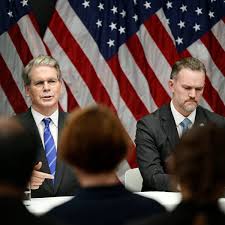The US–China tariff truce is about to expire. This will reshape global trade, raise prices, and fuel economic uncertainty worldwide.

US–China Tariff Truce Deadline Looms – What’s at Stake
The clock is ticking for the United States and China.
Their tariff truce, agreed in April, is set to expire this week.
For months, both sides promised to find a lasting trade solution.
Now, the talks have reached a critical and tense stage.
If no new deal is made, tariffs could snap back into place.
That means higher costs for goods moving between the world’s two largest economies.
Businesses, workers, and consumers in both countries could feel the impact within weeks.
How We Got Here
The US–China trade dispute began in 2018.
The US accused China of unfair trade practices, currency manipulation, and intellectual property theft.
Tariffs followed—first on steel and aluminum, then on hundreds of billions of dollars worth of goods.
China retaliated with tariffs on American exports, hitting farmers, carmakers, and manufacturers.
The cycle continued for years.
Both economies slowed.
Global markets became unstable.
In April 2025, both nations agreed to a temporary tariff truce.
It was meant to create breathing space for fresh negotiations.
Timeline of Key Moments in the Trade Dispute
- March 2018 – US imposes tariffs on steel and aluminum imports, including those from China.
- July 2018 – First wave of tariffs on $34 billion worth of Chinese goods.
- August 2019 – Trade war escalates; more tariffs and Chinese retaliation.
- January 2020 – Phase One trade deal signed, but only partially implemented.
- 2022–2023 – Tensions rise again over technology restrictions and semiconductor exports.
- April 2025 – Temporary tariff truce begins.
- August 2025 – Truce deadline approaches, with talks still unresolved.
The Stakes Are High
If the truce ends, tariffs could rise to 25% or higher on key goods.
Electronics, smartphones, clothing, cars, and even food could become more expensive.
For the US, higher prices could add pressure to already high inflation.
For China, reduced exports could mean factory layoffs and economic slowdown.
This isn’t just about trade—it’s about economic influence.
Both nations see this as a struggle for long-term global leadership.
Political Pressures
Trade talks are never just about economics.
Politics shapes every step.
The Trump–Putin summit in Alaska is also taking place this week.
The geopolitical environment is tense, and decisions made here could influence the mood at the negotiating table.
As www.america112.com notes, even unrelated crises—like the Israel–Gaza escalation—affect global trade confidence.
How It Affects Everyday People
A trade war may seem distant, but it reaches daily life quickly.
A store owner in Chicago might have to raise prices because imports cost more.
A soybean farmer in Iowa could lose contracts with Chinese buyers.
A tech worker in Shenzhen might lose a job if exports fall.
Trade is not just numbers on a spreadsheet—it’s about livelihoods.
What Happens Next
Negotiators are racing to avoid a collapse.
Some analysts believe a last-minute extension is possible.
Others warn political pressures might push both sides into confrontation.
If a deal is reached, markets could calm and trade could stabilise.
If not, the world could see a fresh wave of economic uncertainty.
The Bigger Picture
The US–China tariff truce is more than a trade issue.
It’s part of a broader contest over who will set the rules for the global economy.
Whether this deadline ends in compromise or conflict, it will shape the future of global trade for years to come.


2 Replies to “End of US–China Trade Truce Could Trigger New Economic Tensions”